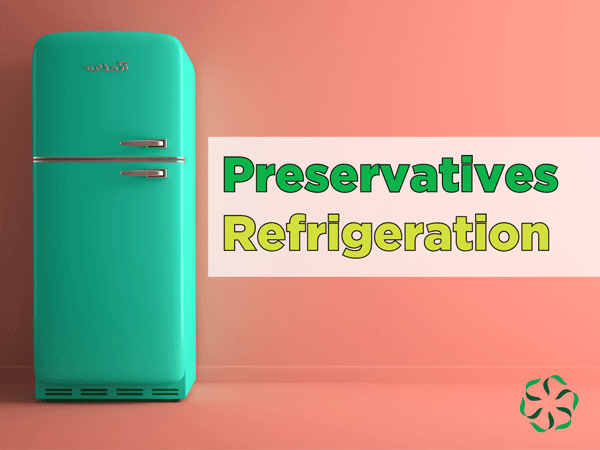In prior posts, we’ve discussed the importance of preservative ingredients in our food supply. In this post, we discuss ways preservative ingredients in conjunction with refrigeration work to help ensure your food remains safe and healthy.
What causes foods to go bad?
Microbes and oxidation are two significant factors that cause foods to go bad quickly.
Microbes that cause spoiling are undesirable bacteria, fungi, and yeasts that grow in our food products. These microorganisms feed off the foods’ nutrients and can cause serious harm to humans if consumed. Without preservatives, bacteria such as listeria and botulism can invade our foods and, if ingested by humans, can cause us to become critically ill. Less harmful bacteria, fungi, and yeasts will grow on foods making them inedible.
Oxidation, a term for specific chemical reactions, can impact food safety and flavor by causing an undesirable chemical change that can turn fats rancid and cause vegetables and fruits, such as cut potatoes and apples, to brown. Enzymes and other chemical breakdown processes are responsible for the oxidation that transforms foods into unpalatable and, at times, unsafe products.
What do preservatives do?
Preservatives and preservation techniques prevent foods from spoiling and oxidizing quickly, allowing grocery manufacturers to distribute foods across the country and the globe without impacting food safety or quality.
What are preservation techniques?
Preservatives are the ingredients and processes we apply to our foods to keep them safe and shelf-stable. There are two key ways we preserve our foods: chemical preservation and physical preservation.
Chemical preservation involves adding specific ingredients to foods and food packaging that allows the food to remain safe and fresh. Humans have been using chemical preservation for thousands of years, and familiar food products such as yogurt, sauerkraut, and kimchi are examples of foods that have undergone chemical preservation.
Physical preservation involves different techniques such as salt curing, refrigeration, smoking, drying, and more to protect food quality. As with chemical preservation, humans have been using physical means to preserve foods since ancient times. One such example is drying and smoking meats, veggies, and more.
These techniques are not mutually exclusive; we often need to use chemical and physical preservation approaches to provide the safest food products with the fewest additional ingredients and processes. Canned foods are a great example of the hybrid preservation approach.
What are common chemical preservatives?
Common antimicrobial preservatives are used to reduce the microbial spoilage of foods by inhibiting the growth of bacteria, yeasts, and molds. Below you will find the ingredient and the products it typically preserves.
- sorbic acid, sodium sorbate, sorbates: cheese, wine, baked goods, and more
- benzoic acid, sodium benzoate, benzoates: jams, salad dressing, juices, pickles, carbonated drinks, soy sauce, and more
- sulfur dioxide, sulfites: fruits, wines, and more
- nitrites, nitrates: meats
- lactic acid: yogurt, kefir, cottage cheeses, and more
- propionic acid, sodium propionate: baked goods, and more
Common antioxidants are used to prevent oxidation. Below you will find the ingredient and the products it typically preserves.
- ascorbic acid, sodium ascorbate: cheese, chips, and more
- butylated hydroxytoluene, butylated hydroxyanisole: oils, packaging, and more
- gallic acid, sodium gallate: wines and more
- sulfur dioxide, sulfites: beverages, wines, and more
- tocopherols (Vitamin E): oils, cereals, and more
What does refrigeration do?
Refrigeration slows both the grown of unwanted microbes and the oxidation process. Indeed, the rate of chemical reaction in general, including oxidation, decrease as the temperature decreases.
It’s a physical preservation technique that we can use exclusively to keep ingredients like fruits, vegetables, and meats fresh longer, or we can use it with a chemical preservation ingredient to further extend the shelf life of foods.
When combined with refrigeration, the presence of chemical preservatives can make food safe to eat for much longer.
Unlike freezers, where most food can stay safe indefinitely but risk losing the properties that make the foods enjoyable, such as texture, flavor, and hydration. Refrigeration only slows the growth processes of unwanted microbes while maintaining most of the textures, flavors, and physical properties that make the foods enjoyable.
Are there some foods with chemical preservatives that still require refrigeration?
You’ll frequently find foods that may be shelf-stable when unopened but require refrigeration once opened.
The preservatives and preservation techniques keep the food shelf safe, but once the food’s exposed to air, heat, humidity, etc., refrigeration helps keep the food safe and fresh longer than if we were to leave it at room temperature. This is due in large part to the fact that many of the microorganisms that can spoil our food are aerobic, meaning that they require oxygen to exist.
Does refrigeration mean fewer preservatives are used?
The amount of preservative ingredients in a product depends entirely on the product and how it’s intended to be stored and used. For example, milk and cheese will have different preservatives and preservation techniques used depending on their storage. Milk that’s ultra-pasteurized and designed to be shelf-stable in a pantry will undergo different processes than milk designed for refrigeration. The same goes for cheese that’s designed to be shelf-stable for long periods and cheese that requires a cool environment to remain fresh.
The good news.
Refrigeration can keep our foods safe and fresh without preservative ingredients. When used with preservatives, we can safely enjoy foods like condiments for more extended periods.

